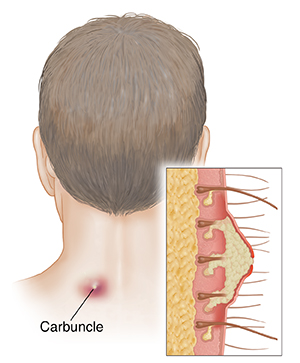A
B
C
D
E
F
G
H
I
J
K
L
M
N
O
P
Q
R
S
T
U
V
W
X
Y
Z
Topic IndexLibrary Index
Click a letter to see a list of conditions beginning with that letter.
Click 'Topic Index' to return to the index for the current topic.
Click 'Library Index' to return to the listing of all topics.
Understanding Carbuncles
A carbuncle is a painful boil under the skin. It happens when a group of hair follicles become infected. Follicles are the tiny holes from which hair grows out of your skin.
 |
| Carbuncle on light skin. |
 |
| Carbuncle on dark skin. |
How to say it:
KAR-bun-kuhl
What causes carbuncles?
A carbuncle is often caused by an infection with a bacteria (Staphylococcus aureus). They are common on areas of the body where friction and sweat occur. They often appear on the back of the neck, back, and thighs. This type of infection can also happen when the skin is injured, such as by a cut or bug bite.
The bacteria that causes carbuncles can spread easily from person to person. People at higher risk for boils are those with diabetes or a weak immune system. Illegal drug users who use needles are also more likely to get them.
Symptoms of carbuncles
A carbuncle starts as a small painful bump. But it can grow quickly. It may become:
Carbuncles may ooze pus. They may also cause fever and a general feeling of illness.
Treatment for carbuncles
A carbuncle may heal on its own in a few weeks. But the pus within it needs to come out first. Treatment options include:
-
Warm compress. Putting a warm, wet washcloth on the boil will help the pus drain out. You should never try to pop a boil. That can cause the infection to spread. To avoid spreading bacteria, wash the towel well after using it.
-
Surgical drainage. If the boil doesn’t drain on its own, your healthcare provider may need to cut into it.
-
Antibiotics. In some cases, oral antibiotics may be prescribed to fight the infection, especially if the carbuncle returns. You'll likely have to take the medicine for 5 to 7 days. You may need to take it longer for a severe case.
-
Good hygiene. Proper handwashing can prevent boils from spreading and coming back. Also wash things that have been in contact with the carbuncle in hot water. This includes items such as clothing and towels.
Complications of carbuncles
The main complication of a carbuncle is the spreading of the infection. The infection will often be contained with treatment. But it may spread into the nearby skin. In severe cases, the bacteria can go deeper, even infecting the heart or bone. Bacteria in the bloodstream can also lead to septic shock, a life-threatening reaction.
When to call your healthcare provider
Call your healthcare provider right away if you have any of these:
-
Fever of 100.4°F (38°C) or higher, or as directed by your provider
-
Redness, swelling, or fluid leaking from a carbuncle that gets worse
-
Pain that gets worse
-
Symptoms that don’t get better, or get worse
-
New symptoms
Online Medical Reviewer:
Michael Lehrer MD
Online Medical Reviewer:
Raymond Kent Turley BSN MSN RN
Online Medical Reviewer:
Tennille Dozier RN BSN RDMS
Date Last Reviewed:
3/1/2022
© 2000-2024 The StayWell Company, LLC. All rights reserved. This information is not intended as a substitute for professional medical care. Always follow your healthcare professional's instructions.